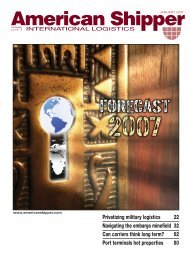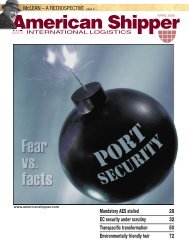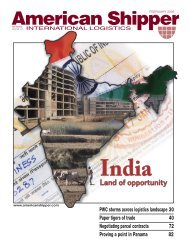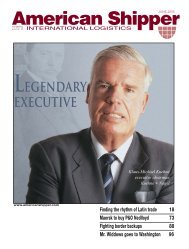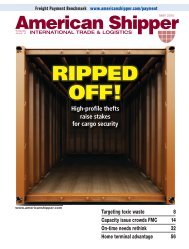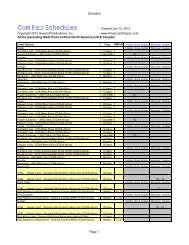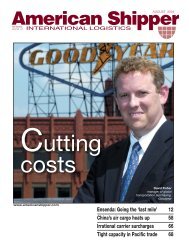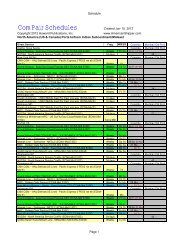Pirate Busters - American Shipper
Pirate Busters - American Shipper
Pirate Busters - American Shipper
You also want an ePaper? Increase the reach of your titles
YUMPU automatically turns print PDFs into web optimized ePapers that Google loves.
AGOA benefits beyond 2015.<br />
Lafont said Africa’s farmers and agriculture<br />
industry faces many challenges.<br />
“International competition is not very<br />
fair to Africa. There are a lot of subsidies,<br />
and it is difficult for Africa to stabilize its<br />
agriculture because of the great variation<br />
in commodity prices,” he said. A stronger<br />
agricultural sector could benefit the continent<br />
greatly, he added, encouraging people<br />
to farm rather than move to the city.<br />
Madsen of APM said that going back<br />
to colonial times, Europe dominated trade<br />
with Africa. But there has been a big shift<br />
over the past decade with Asia, particularly<br />
China, becoming the region’s biggest trading<br />
partner, particularly as an exporter of<br />
consumer goods.<br />
Except for a small number of countries<br />
,such as South Africa or Egypt, not many<br />
consumer goods are produced in Africa,<br />
and China has become a major source for<br />
products such as clothing and electronics,<br />
he said.<br />
Africa is “a continent where you import<br />
consumer goods and you export raw materials,”<br />
Madsen said.<br />
That has a big effect on shipping, with<br />
many exports leaving on bulk or breakbulk<br />
vessels, while many imports arrive in<br />
containers. Many export containers, carry<br />
“fresh air,” he said.<br />
As containerization has become more<br />
prevalent over that past 10 to 15 years,<br />
many African ports have expanded container<br />
facilities, converting old general<br />
cargo docks into container ports. Many<br />
also handle roll-on/roll-off ships as imports<br />
of new and second-hand cars move to the<br />
continent from Europe or the United States.<br />
Stephen Hayes, president of the Corporate<br />
Council on Africa, believes “the U.S.<br />
needs to be much more actively engaged<br />
in Africa. The U.S. technically is still the<br />
largest investor in Africa but about 70 to<br />
80 percent is oil and oil-related matters, so<br />
it’s not long-term investment. It’s not like<br />
a 50-year investment, but probably a 10-20<br />
year investment.<br />
“We need to invest in just about every<br />
other sector and throughout the continent,”<br />
he continued. “If you take several countries<br />
out of the picture, then the U.S has very<br />
little investment in Africa. Compare that to<br />
China, which is invested in just about every<br />
country in Africa. Also Japan, India and<br />
LOGISTICS<br />
the Gulf states are increasing investment.<br />
Once you take energy out of the equation,<br />
even South Africa is a larger investor in<br />
the West of Africa than the U.S.”<br />
Lack of infrastructure has a strong effect<br />
on how the shipping industry operates<br />
in Africa.<br />
“If containers are bound for delivery in<br />
consumer areas of big cities, it goes out to<br />
distribution warehouses,” Madsen said.<br />
But in many locations if cargo is bound<br />
for or originates far inland, it is stripped<br />
or stuffed at the port because roads are<br />
not good enough to run container trucks.<br />
Lafont agrees. “Unfortunately the roads<br />
are not good enough, and I am afraid to say<br />
they are probably deteriorating” in many<br />
locations. Weight restrictions are often<br />
ignored, though he said some countries<br />
are installing scales to prevent overloading<br />
of containers.<br />
However, there are some exceptions.<br />
South Africa has a well developed rail<br />
and road system. Safmarine has its own<br />
trucking company and it uses the national<br />
rail system to move containers inland to<br />
reach population centers like Johannesburg.<br />
Madsen said there are container trains<br />
‘Between us and our big brother (Maersk), we probably have 40-45 percent<br />
of the West African market,’ Safmarine’s John Boudreau said.<br />
same operations and facilities, and in many<br />
cases we’re loading on the same vessel<br />
at the same port terminals. The Maersk<br />
model of operational excellence is one that<br />
we benefit from, having as few exceptions<br />
as possible.”<br />
Safmarine offers direct, fully containerized<br />
weekly sailings from the U.S. East and<br />
Gulf coasts to South Africa. Cargo to West<br />
Africa is often relayed via Mediterranean<br />
ports or Las Palmas in the Canary Islands.<br />
It serves East Africa, generally by transshipping<br />
through Durban in South Africa<br />
or Salalah in Oman.<br />
Boudreau said the company tries to distinguish<br />
itself from competitors by offering<br />
intensive customer service.<br />
“We will expend a lot of energy with our<br />
own people to protect our customers from<br />
any internal snafus or any problems we<br />
might have with a system. And if there are<br />
exceptions we deal with them as personally<br />
as we can to solve their problems.<br />
“Our business is a little bit less predictable<br />
coming from a broader number of customers<br />
generally smaller in size,” he added.<br />
The company can face challenging<br />
conditions in some ports, though he said<br />
the economic slowdown has given some a<br />
breather to catch up on growing volume.<br />
Maersk has grown its fleet substantially<br />
in recent years, taking seven new vessels<br />
in 2008 and two earlier this year. No more<br />
are planned in 2009, but the company will<br />
add to its fleet in 2010 and 2011.<br />
Safmarine has done better than many<br />
carriers during the downturn in container<br />
business this year, maintaining container<br />
volumes at the same level in the first half<br />
of 2009 as in the same 2008 period. But it<br />
is not unscathed; in late July it said it would<br />
withdraw from the transpacific at the end<br />
of June 2010, telling customers profitable<br />
participation in the trade lane was difficult<br />
because of its small size and poor conditions<br />
in the market.<br />
“There is a huge tie-in between Safmarine<br />
and South Africa. The company began<br />
as a venture starting service between New<br />
York and South Africa. The roots run very<br />
deep we have in many cases South African<br />
officers,” Boudreau said.<br />
The company has built a maritime academy<br />
in South Africa to train workers, and it<br />
has an active program called Containers in<br />
the Community, where it donates containers<br />
to build schools and other community<br />
facilities.<br />
AMERICAN SHIPPER: OCTOBER 2009 13



